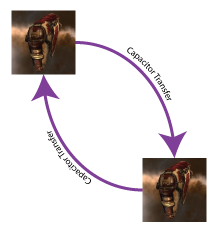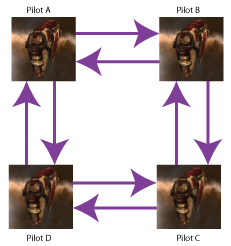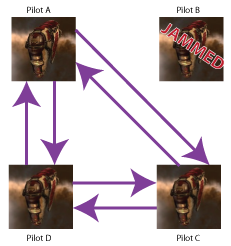Difference between revisions of "Remote repair fleets, ships and fittings"
(→Staggering Triage) |
(→Linking Up) |
||
| Line 259: | Line 259: | ||
The other element working in these two ship's favor is a high number of high slots. Both have six high slots, where the scimitar and oneiros only have four. The greater number of high slots allows the guardian and basilisk to fit energy transfer arrays without sacrificing the number of remote repair modules. | The other element working in these two ship's favor is a high number of high slots. Both have six high slots, where the scimitar and oneiros only have four. The greater number of high slots allows the guardian and basilisk to fit energy transfer arrays without sacrificing the number of remote repair modules. | ||
| − | ==== | + | ====Cap Chains==== |
Revision as of 21:06, 27 April 2011
Contents
Introduction
This article assumes you have read:
It will take the basic concepts contained therein and expand them into the practical by demonstrating a wide variety of fleets and practical notes about being a Remote Repair pilot.
Pre-Canned fittings will not be provided as we assume at this point you can use EFT and can fit out a ship based on general instructions. Instead, fitting notes will be provided for key ships to give you the guidance you need to customize your ships for differing situations.
Obviously the fleets and tactics listed here are not exhaustive, they are here to serve as a good grounding in the use of remote repair ships and concepts in your fleets.
Skill Notes for Fitting
Before we get to the fleets and fittings, there are several important skills that are required to put these into practice.
Targeting Skills
As covered in Remote repair time line and cycle management , maintaining targets and locking targets quickly are major factors in the success of a remote repair pilot. The following skills are suggested to improve this element:
- Long Range Targeting (4): This skill increases your range to target. The range of a bonused large remote repair module (on a Basilisk, Guardian, Scimitar or Oneiros) is 71.4km. To be able to target to that range on all 4 Logistic hulls, you must have at least a 4 in Long Range Targeting.
- Multitasking (3): The maximum number of targets a T2 Support Cruiser ship can target is 10. To reach this you need targeting 5 and multitasking 3 (2 base + 5 targeting + 3 multitasking). Since the number of targets you can lock and keep track of is critical to a remote repair pilot, it is strongly suggested you get up to multitasking 3.
- Signature Analysis (up to 5): This affects your targeting speed, getting this to 5 is useful.
Fitting / Capacitor Skills
When fitting logistic boats (Basilisk, Guardian, Scimitar or Oneiros), you are frequently fitting multiple large remote repair modules on a cruiser sized hull. Each of these ships have a bonus to fitting certain remote repair modules, however chances are your fitting will be tight. The following skills are not required, but will make fitting a logistic boat much easier.
- Electronics: Helps with ship CPU output.
- Electronics Upgrades: Reduces CPU needs of electronic upgrade modules (co-processors and the like)
- Engineering: Helps with ship powergrid output.
- Energy Grid Upgrades: Reduces CPU needs of power upgrades (capacitor chargers and the like)
When using remote repair modules, cap management will always be a factor. To help mitigate this, the following skills will be useful.
- Energy Management: Increases capacitor capacity.
- Energy Systems Operation: Recharges capacitor faster.
Logistics / Systems Skills
Remote Repair Module Skills
Although they affect fitting, these skills are necessary in their own right and merit special comment.
- Energy Emission Systems
- Capital Energy Emission Systems
- Shield Emission Systems
- Capital Shield Emission Systems
- Remote Armor Repair Systems
- Capital Remote Armor Repair Systems
- Remote Hull Repair Systems
- Capital Remote Hull Repair Systems
Each of the above reduces the amount of capacitor used by remote repair modules of a particular kind. You should have at least 4 in those of these that you are utilizing.
Logistics
In addition the great grand-daddy skill for remote repair pilots is the Logistics skill. This skill cannot be emphasized enough. Normally when dealing with a specialty ship a 3 or 4 is usually sufficient to be considered proficient. With T2 Support Cruisers, you absolutely must have at least a 4 and preferably a 5 in this skill to even be able to effectively use them appropriately. Each skill level in this gives a 15% reduction in capacitor use of the appropriate modules (more on this later).
A common question is whether a 5 is worth training in this skill. The answer is unequivocally a yes. It is difficult to quantify without talking about specific fits, but the difference between 4 and 5 in this skill is much more significant to the piloting of T2 Support Cruisers then the difference between 4 and 5 of any other spaceship command skill is to their respective hulls.
Implants
In addition to skills, the following implants are useful for a variety of reasons and should be considered when purchasing implants. Not all of these are appropriate to all situations or wallets nor can all of these be fit at the same time.
Implant sets are typically very expensive. Other implants usually come in a 1% version, 3% version and a 5% version. The 3% version is usually reasonably priced and accomplishes a decent bang for the buck. Unless you are extremely wealthy or using remote repair in relatively safe situations, the 5% implants are usually not worth the ISK.
Sets
- Low-grade Grail/Jackal/Spur/Talon Sets: Each of these sets give bonuses to a specific sensor strength. One of the largest dangers to a remote repair vessel is ECM. These in conjunction with the appropriate ECCM can significantly help combat ECM.
- Low-grade Talisman Alpha: Useful in some paired Guardian/Basilisk scenarios, this reduces the duration of energy emission systems and therefor allows more cap to be transferred.
Slot 6
- Hardwiring - Zainou 'Gypsy' KMB 25, 50 and 75: These increase your CPU output and can be necessary depending on fitting.
- Hardwiring - Inherent Implants 'Squire' PG 2, 4, 8: These increase your power output.
- Hardwiring - Inherent Implants 'Squire' CR 2, 4, 8: These increase your cap recharge rate.
Slot 7
- Hardwiring - Inherent Implants 'Noble' ZET 20, 200, 2000: These decrease capacitor use of remote armor repair systems.
- Hardwiring - Zainou 'Gypsy' KNB-25, 50, 75: These increase your scan resolution and by extension shorten your lock time.
- Hardwiring - Inherent Implants 'Squire' EE2,4,8: These decrease capacitor use of energy emissions systems.
Slot 8
- Hardwiring - Zainou 'Gnome' KXA500,1000,2000: These decrease capacitor use of remote shield transfer arrays.
Remote Repair Ships
This is just a list of remote repair bonused ships for reference, how to fit and use these is covered later or elsewhere in the class material.
T1 Cruisers
Each race has a T1 Cruiser with bonuses related to remote repair, tracking links and energy transfer. These are not seen often in remote repair fleets as their bonuses are generally too narrowly focused and they do not receive fitting bonuses restricting them to only small and medium remote repair modules. There have been exceptions however and therefore these bonused ships require some note.
- Amarr: Augoror: Receives a capacitor use and range bonus to energy transfer arrays. (in addition to an armor hitpoints bonus)
- Caldari: Osprey: Receives a capacitor use and range bonus to shield transporters. (in addition to a mining bonus)
- Gallente: Exequror: Receives a capacitor use and range bonus to remote armor repair systems. (in addition to a cargo bonus)
- Minmatar: Scythe: Receives an effect and range bonus to tracking links. (as well as a mining bonus)
Guardian and Basilisk
The Guardian and Basilisk are the first two T2 Support Cruisers that we will look at. These are grouped together because of their similar bonuses (bonsuses to remote repair modules as well as energy transfer modules) that make them uniquely suited for large fleet work as we will see later.
Guardian
Hull: Augoror Class
Role: Support Cruiser
Amarr Cruiser Skill Bonus: 150% bonus to Energy Transfer Array and Remote Armor Repair System range and 20% bonus to Armor Maintenance Bot transfer amount per level
Logistics Skill Bonus: 15% reduction in Energy Transfer Array and Remote Armor Repair System capacitor use per level
Role Bonus: -65% power need for Remote Armor Repair Systems and -50% power need for Energy Transfer Arrays
Basilisk
Hull: Osprey Class
Role: Support Cruiser
Caldari Cruiser Skill Bonus: 150% bonus to Shield Transport and Energy Transfer Array range and 20% bonus to Shield Maintenance Bot transfer amount per level
Logistics Skill Bonus: 15% reduction in Shield Transport and Energy Transfer Array capacitor use per level
Role Bonus: -50% CPU need for Shield Transporters and -50% power need for Energy Transfer Arrays
Scimitar and Oneiros
The last T2 Support Cruisers also have similar bonuses (remote repair bonuses as well as tracking link bonuses) that mark them better for smaller fleet work, in the role of a repair and utility ship, as we will see later.
Scimitar
Hull: Scythe Class
Role: Support Cruiser
Minmatar Cruiser Skill Bonus: 150% bonus to Tracking Link and Shield Transport range and 20% bonus to Shield Maintenance Bot transport amount per level
Logistics Skill Bonus: 10% bonus to Tracking Link efficiency and 15% reduction in Shield Transport capacitor use per level
Role Bonus: -50% CPU need for Shield Transporters
Oneiros
Hull: Exequror Class
Role: Support Cruiser
Gallente Cruiser Skill Bonus: 150% bonus to Remote Armor Repair System and Tracking Link range 20% bonus to Armor Maintenance Bot transfer amount per level
Logistics Skill Bonus: 15% reduction in Remote Armor Repair System capacitor use and 10% bonus to Tracking Link efficiency per level
Role Bonus: -65% power need for Remote Armor Repair Systems
Heavy Metal (carriers)
Carriers are one class of the ships you commonly hear people new to eve state that they want to eventually fly. In addition to their role in remote repair they make excellent fleet support ships (being able to fit warfare links and allow fleet ships to refit), great transport platforms for fitted ships as well as decent damage dealers with bonuses to drones and fighters.
With the addition of tactical logistics reconfiguration modules, they can become a powerhouse of repair... even if sometimes as the adage goes the candle that burns twice as bright lasts half as long.
Archon and Chimera
With bonuses to the range of their respective remote repair modules as well as energy transfer modules, these make for great multi-carrier repair squads. The addition of bonuses to tank on each make them ideal triage carriers. Common thinking places the Archon as much better than the Chimera due to its armor focus since the focus of most large battleship and capital fleets tends to be armor, however in the role of POS shield repairing and POS defense under fire, the Chimera does find its role.
Archon
Amarr Carrier Skill Bonuses:
50% bonus to Capital Energy and Armor transfer range per level
5% bonus to all Armor resistances per level
99% reduction in CPU need for Warfare Link modules
Can fit Tactical Logistics Reconfiguration modules
Can deploy 1 additional Fighter or Drone per level
200% bonus to Fighter control range
Chimera
Caldari Carrier Skill Bonuses:
50% bonus to Capital Energy and Shield transfer range per level
5% bonus to all Shield resistances per level
99% reduction in CPU need for Warfare Link modules
Can fit Tactical Logistics Reconfiguration modules
Can deploy 1 additional Fighter or Drone per level
200% bonus to Fighter control range
Thanatos and Nidhoggur
The final two carriers seem designed for more general use granting bonuses to both shield and armor remote repair module ranges as well as damage bonuses to fighters or repair rate. Although they can and have been seen in the triage carrier role, they seem less suited for the task because of the lack of a tank bonus. As with the Archon and Chimera, the higher armor tank of the Thanatos tends to edge out the Nidhoggur in popularity although the repair rate bonus of the Nidhoggur means that it is no slouch itself.
Thanatos
Gallente Carrier Skill Bonuses:
50% bonus to Capital Shield and Armor transfer range per level
5% bonus to deployed Fighters’ damage per level
99% reduction in CPU need for Warfare Link modules
Can fit Tactical Logistics Reconfiguration modules
Can deploy 1 additional Fighter or Drone per level
200% bonus to Fighter control range
Nidhoggur
Minmatar Carrier Skill Bonuses:
50% bonus to Capital Shield and Armor transfer range per level
5% bonus to Capital Shield and Armor transfer amount per level
99% reduction in CPU need for Warfare Link modules
Can fit Tactical Logistics Reconfiguration modules
Can deploy 1 additional Fighter or Drone per level
200% bonus to Fighter control range
Fleet Types and Fittings
Spider Tanked Battleship Fleets
The idea behind spider tanking involves distributing the remote repair ability throughout the fleet allowing you to focus on a larger buffer and resist tank as well as being resistant to single or multiple ships being disabled due to ECM, death, etc. The power of remote repairers instead of local repair tanks is that in most cases a fleet will attempt to focus fire to bring the most damage against single or small numbers of ships to kill them quickly. With a local tank you can only have so much repair on your ship effectively wasting the rest of the fleet's repairing since they are not getting hit. With remote repairs, the fleet's repair is put to good use as the primary targets can gain the benefits of multiple ship's repair power.
Although this fleet type seems to be waning in popularity as compared against having dedicated logistics, it is definitely not dead and can have a devastating effect on the battlefield. Typically these fleets are armor based due to being able to fit a large tank in the lows as well as ewar and cap boosters in the mids, however shield based spider tanks are definitely possible.
The key when designing a spider tanked fleet is to focus on buffer and resist tanking first, mount at least one large remote repair module per ship and while fitting the remaining slots to be very aware of cap management (since frequently large fleet (both in size and numbers) engagements can last longer then smaller fleet engagements). It is often useful to sculpt these fleets instead of having individual ships fit individually.
The weakness to this type of fleet lies in three elements: the previously mentioned cap management issues (due to the high cap use of remote repair modules), communication (a common issue among remote repair fleets) and human issues. Human issues come into play because instead of just dealing with the tasks involving repairing (which alone is quite a lot), you have to deal with managing your tactical positioning in relation to your fleet (to stay in remote repair range) and the enemy and still try and put the hurt on the enemy. These are heightened by having both friendlies and enemies in your target list causing some pilots to get confused and repair an enemy while shooting a comrade.
If the above weaknesses can be managed, this can be a useful and fun tactic.
Dual (or more) Guardian or Basilisk Fleets
The central tenant of multiple remote repair fleets of this kind centers around the fact that in a properly bonused ship, remote energy transfers produce more energy in their target then is spent activating the module. This makes for a very difficult thermodynamics equation, but also makes for a very useful way to be able to generate the capacitor to run cap hungry remote repair modules.
Why just Guardians and Basilisks
There are two reasons why this technique is almost always done with Guardians and Basilisks. The first is the natural bonuses of Guardians and Basilisks are what make this possible. As an example, a Large 'Regard' I Power Projector normally costs 338GJ to activate giving 324GJ to the target causing a net loss of 14GJ. With a maxed skilled guardian, that changes to an activation cost of around 67.5GJ giving a net gain of 256.5GJ. With maximum skills in a non-bonused ship, you can get the activation to 270.5 for a gain of 53.5GJ, but a net gain of 5x that number from the guardian or basilisk is much more desirable.
The other element working in these two ship's favor is a high number of high slots. Both have six high slots, where the scimitar and oneiros only have four. The greater number of high slots allows the guardian and basilisk to fit energy transfer arrays without sacrificing the number of remote repair modules.
Cap Chains
Dual Ship
Multi-Ship
Broken Chains



